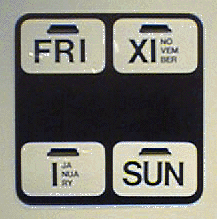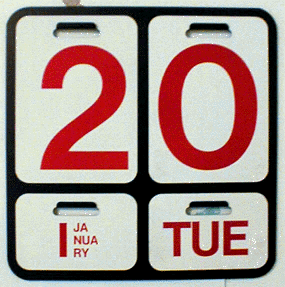 Welcome
Welcome

Please, my reader, excuse that the two above images are not perfect. They are the best I (BMcC[18-11-46-503]) have.
They tell at least 3 stories.
First: The Danese wall calendar is an icon of modern design that, in 1968, any middle-class Americn could afford if he or she had the education and spirit to want one. In 1968, it cost US$20. What is modern design? The very title of Adlof Loos's essay/manifesto: "Ornament and crime", which I highly recommend, sums it up: Ornament is criminal or, as Loos continues, degenerate. You, my reader, will note that this thesis diametrically contraposes post-modernism which celebrates ornament (Item: Robert Venturi's Quaker home for the aged, "Guild House", Philadelphia, Pennsylvania), and which I consider criminal and degenerate.
One of the watchwords for modern design was: "Less is more", which meant freeing persons from being spiritually choked/stuffed (like geese being prepared for foie gras) under the pompous trumpery of Victorian kitsch decoration. The faux "classical" monuments and monumental veneered buildings that in our own time Adolf Hitler still savored, etc. Post-modernists would replace old model Beaux Arts decoration with new model neo-cynical decoration, make us be foie gras geese again, and maybe their motto should be: "More is more" (if the world is spherical, why shouldn't we be spherical too?). Another modernist slogan: "God is in the details"(Mies van der Rohe) Post-modernists? God is in the gawks.
Second: The story of how I got my calendar (above right) is perhaps instructive. I really wanted one of these wall calendars in 1968 to put on the wall of my efficiency apartment. There was a modern design store in Baltimore Maryland, where I lived, that had one on its wall, near the cash register. I entered the store and requested to buy one. The clerk told me they were out of stock but they had them on order, so I should come back in a couple weeks. I did come back. What they offered me was something different: a wall calendar with flip cards for setting the date, but the proportions were not right and the construction was cheaper. No, I did not want this. I wanted one of the calendars like they had on their wall. The clerk responded to me, almost threateningly, but definitely accusatorily, asking me if I wanted the one they had on the store's wall. After being momentarily taken aback, I replied "Yes". The clerk did the right thing, and I got my Danese wall calendar. The store got a little more money but was poorer; I had a little less money but was richer.
Third: The picture above left is a photograph I took documenting a Danese wall calender in the design collection of The Museum of Modern Art (aka MOMA), New York City. It is clearly f-cked up. I think it speaks for itself of the lack of concern the curatorial staff of that august institution must have had for such a humble object which, yet, for some reason, was, nonetheless, to use a term from Edmund Husserl, in some way an intentional object for somebody there. I say "Shame on them!"
There is hypocrisy or at best thoughtlessness in consorting with "great modern art" (Matisse, Picasso, et. al. paintings and sculptures with insurance valuations > US$1 x 10 **6) but treating a relatively humble icon of modernity (did they deem it worth insuring?) like shit, even though, for some reason, they had decided to accession and display it. This, to me, is reminiscent of the disappointment Ulrich, The Man Without Qualities in Robert Musil's novel of the same name, felt when, taking a job in an engineering office, he found the engineers, who practiced the spirit of presision in their work, in their lives wore tacky tie tacks with little horse heads on them. Kitschmenschen.
I feel pity for all these folks, both Musil's fictive engineers and the also the all too real presumably art history graduate degreed employees of MOMA. But they, especially the MOMA employees, are not just victims. In their not-felony-chargeable way, they are also executiomers. MOMA has an Education Dept. But this little calendar teaches by example: In Everyman, woman, child's everyday life, which is not the Empyrean of 7 and 8 figure insurance valuations and MOMA curatorships, "Who cares? And, why bother?"
I say: A pox on them all! But perhaps nobody except me noticed, and maybe even they fixed the calendar, presuming they had not lost the missing calendar cards. I don't know.

Office buildings are paradigmatic "modern architecture". I once worked in perhaps one of the finest modernist buildings, Eero Saarinen's IBM Thomas J. Watson Research Center, Yorktown Heights, New York. Why do I think it was good? Well, it is beautiful to look at. But, far more important, the layout of the building was to have every person's office including the Director's in the building's perforce windowless inner space (no corner offices for only the big bosses and side offices with windows only for lesser sub-lunar luminaries!), reserving all the precious natural lit space of the building's perimeter for public [cf.: Roman res publica...], but also human scale main aisles.
+2021.05.07. I now see there is a serious problem with what I have written here about the IBM Watson Research Center: It is a great humanistic building, but it is not an office building. An office building cannot be a great humanistic building because "office work" is not humanistic human activity. Saarinen's building is a great: research center. Maybe Mies van der Rohe's Seagram Building is a "great" office building, but it's still an office building, and therefore it cannot be a great humanistic building without replacing "office work" with something humanistic. Mies's Seagram Building is less worse than e.g.: Philip Johnson's "Chippendale skyscraper" because it is more architecturally honest, but no office building can be really good, because "office work", i.e.: what goes on in the building, is bad. Therefore, read the rest of this section about a great humanistic building, just it's not an office building. Somebody, be it an architect, an industrial sociologist or whoever needs to replace "office work" with a good kind of human activity, then we will be able to have more good buildings. Bad architects can, of course, make bad buildings for even the best human activities.
The building is quite long, but its gently curving shape (above right) prevented these aisles from feeling discouragingly "endless" since one could only see "so far" forward or back around the curve, not to the end. And these aisles included at the interval of each staircase (50 feet?) a small area with a white-board, where small groups of employees could spontaneously get together to discuss things or maybe an individual could just sit and read or think, while also seeing the natural world outside. The aisles also had public Xerox [I forget the brand] machines [Ah! An old IBM motto was: "THINK". There was even a part-number for ordering a little desk placard.]

IBM initially showed they deserved the building, even in such small ways as the Library accessioning books – Item: Joseph Needham's "Science and Civilization in China" – and subscribing to journals – Item: Unesco "Impact of science on society" – with no business case.
The "Watson Lab" is good because it nurtured humanistic values in the lives of the persons who spent a good part of their lives in it. I contrast this with a lot of what are called "modern" buildings, e.g., the big box-shaped office towers in Manhattan. I.M. Pei's World Trade Center towers are, of course, gone. I've never been inside it, but I'm guessing Mies van der Rohe's Seagram's Building, which I think is still around, is one of the best examples. I cannot imagine how such a layer cake of office floors nurtures the persons who work in it, unless the rest rooms and employees' work stations are inspiringly designed.
These buildings are not to "the human scale", so I think entering them would make one feel small. This is architecture which, while freed from decoration, is not freed for very much. No wonder "modernism" gets a bad rap, of which post-modernists take advantage to build stuff that is positively i.e., negatively, nefarious. (Consider, e.g., The Cabinet of Dr. CaliGehry:
"CLEVELAND, May 10 [2003] – The police said today that a gunman who killed one person and wounded two in a seven-hour attack here... led SWAT teams on a maddening 'cat-and-mouse' chase through one of the nation's most idiosyncratic architectural complexes, the building that houses Case Western Reserve University's... Weatherhead School of Management... a brick complex topped with towering bursts of undulating stainless steel... designed by Frank Gehry. Its avant-garde design led to a prolonged hide-and-seek between SWAT team members and the gunman in a building that defies conventional shape. Officers chased the man... over several floors. 'There are no right angles in the building,' said Chief Edward Lohn of the Cleveland police. 'There's a trail of blood throughout,' he added. 'The cat-and-mouse game moved room to room, floor to floor in that building.'" (Danny Hakim, "Ex-Employee Held in Campus Attack", NYT, 11May03, p.A19)
Most of the objections to modernism are, I think misplaced. The problem is that we have never yet really been modern, if being modern means building a genuinely nurturing, self-reflective and self-accountable social world, a world not of Seagram's buildings [impersonal boxes] but of Watson Labs. Full modernity lies if anywhere largely ahead of, not behind us.
The universal of modernity is not in any physical entity but in the minds of persons wherein all times and all places and all things find their place. It would be, perhaps paradigmatically, for one instance, in the mind of Edmund Husserl writing his texts, and, then, in our minds who read and further reflect on and elaborate them. The New York Times recently (12 June 2020) had an interview with Bob Dylan which would also go here. Everywhere and nowhere. The spirit of modernism can be anywhere, from a website (e.g, here) to a city, if the latter is a place where, as Louis Kahn said, a small child, going from the workplace of one master craftsperson to another, may find something he or she wants to do their whole life. Living desire, not need. I think Louis Kahn was a great modern architect, because, in addition to designing honorific buildings, he also was a deeply humanistic crafter of words.
But, to borrow from Elie Wiesel's dictum, Don't compare. Kahn and Husserl were giants. That does not make them any bigger or smaller than world War II Petty Officer First Class Isadore Znamirowski's achievement of inventing the insignia on United Stated military aircraft ("star and bars").
The origin of all constructive human creative achievement is beyond thought and speech. The result is in each case something for which to give thanks. (Aside: I add the adjective "constructive" here because, as Sophocles wrote, according to Martin Heidegger's translation: "O clear intelligence. force beyond all measure. O fate of man working both good and evil". Heidegger himself is an instance here, being both a monumental creative thinker, but also a Nazi, and I think "the final solution" was somebody's creative invention. Only death or dementia brings an end to Heideggerean Holzwege, aka, the endlessly brachiating, sometimes for good, sometimes for evil, pathways of thinking. Intelligence alone is not good enough; empathy and wisdom are also required.)
My reader, you may entertain the thought that I (BMcC) have a discouraged view of "the world" 2020CE. I do not deny that. There is a photograph which epitomizes my feelings here: Robert Capa's DENMARK. Copenhagen. November 27th, 1932. Leon Trotsky lecturing.. This photograph is, to me, remarkable, especially due to the effects of the negative being damaged. Capa made other similar photograph of the same subject, which does not have damage, and which does not much interest me, precisely for the lack of effects of damage. My title for this photograph is:
Broken picture of a broken man lecturing the broken dreams of a broken century
